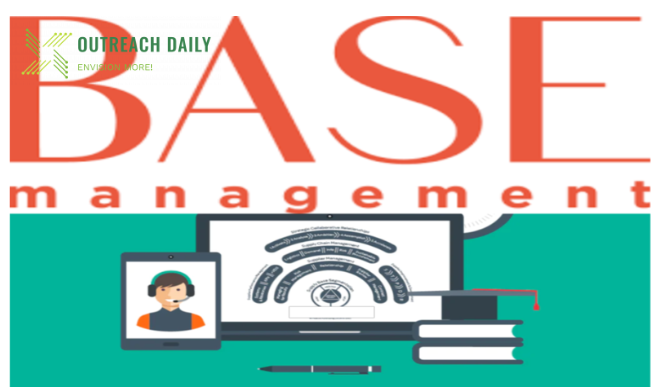Introduction:
Base management is a critical part of various industries including manufacturing, logistics, retail and many others. The term refers to the process of effectively organizing, directing and optimizing the resources, facilities and operations from a central location or “base.” A well-managed base can have a significant impact on an organization’s efficiency, productivity and bottom line. This article explores the complexities of Base management and discusses key strategies and best practices for success.
Understanding Base Management:
Base management includes a wide range of functions designed to ensure the smooth operation of the central facility. This can include factories, warehouses, distribution centers, retail stores and more. The main objective is to maximize the utilization of resources, minimize waste and simplify operations to improve overall efficiency.
Key Components of Base Management:
The key components of base management are explained below,
a. Resource Allocation and Utilization:
Effective base management begins with the effective allocation of resources such as personnel, equipment and raw materials. This includes optimizing work schedules, dividing tasks and ensuring that resources are fully utilized. Resource allocation and utilization are essential components of effective key management. Properly allocating resources and ensuring they are used effectively can have a significant impact on an organization’s productivity, profitability and overall success. In this section, we delve deeper into the concepts of allocation and use of resources in the context of basic management.
1. Resource Allocation:
Resource allocation refers to the allocation of available resources (such as personnel, equipment, time, and funding) to different tasks, projects, or departments on a basis. The goal is to optimize the use of these resources to achieve organizational goals by minimizing waste and maximizing efficiency. Here are some key considerations for efficient resource allocation,
i. Identify Priorities:
Understand the organization’s strategic goals and prioritize tasks or projects that align with these objectives. Allocate resources to high-priority activities that contribute the most value.
ii. Allocate Based on Demand:
Allocate resources based on demand forecasts and historical data. This prevents overallocation to tasks with low demand and ensures that resources are available when and where they are needed the most.
iii. Balancing Workload:
Distribute tasks and responsibilities evenly among available personnel to prevent overburdening certain teams or individuals. Avoid situations where some teams are overloaded while others are underutilized.
iv. Flexibility:
Maintain a degree of flexibility in resource allocation to accommodate unexpected changes in demand, emergencies, or new opportunities. Being able to reallocate resources quickly can enhance adaptability.
v. Cross-Functional Collaboration:
Foster collaboration between different departments to share resources effectively. Cross-functional teams can pool resources and expertise to achieve common goals.
2. Resource Utilization:
Resource utilization refers to the extent to which available resources are used effectively and efficiently to complete tasks and projects. Optimizing resource usage is essential to minimize waste, reduce costs and improve overall productivity. Here’s how you ensure efficient use of resources,
i. Monitor Performance:
Implement tracking mechanisms to monitor the performance of resources in real-time. This can include tracking machine uptime, employee productivity, and equipment utilization rates.
ii. Performance Metrics:
Define key performance indicators (KPIs) related to resource utilization. These metrics could include utilization rates, cycle times, throughput, and downtime percentages.
iii. Identify Bottlenecks:
Identify bottlenecks or areas where resources are being underutilized or overutilized. Addressing bottlenecks can improve overall efficiency and prevent delays.
iv. Training and Skill Development:
Ensure that employees are properly trained to use equipment and resources effectively. Well-trained employees can operate machinery efficiently and minimize errors.
v. Maintenance and Upkeep:
Regularly maintain and service equipment to prevent breakdowns and downtime. Properly maintained equipment operates more efficiently and has a longer lifespan.
vi. Data-Driven Decisions:
Use data analytics to make informed decisions about resource allocation and utilization. Analyzing historical data can reveal patterns and insights for optimizing resource usage.
vii. Continuous Improvement:
Encourage a culture of continuous improvement where teams regularly evaluate processes and seek ways to enhance resource utilization. Solicit feedback from employees who are directly involved in operations.
b. Inventory Management:
For manufacturing and distribution bases, inventory control is crucial. Implementing inventory management systems, demand forecasting, and just-in-time practices can prevent overstocking or stockouts, leading to cost savings and improved customer satisfaction.
c. Maintenance and Repairs:
Regular maintenance of machinery, equipment, and facilities is essential to prevent unexpected downtime. Implementing preventive maintenance schedules and prompt repairs can extend the lifespan of assets and reduce disruptions.
d. Health and Safety:
A well-managed base places a high emphasis on health and safety protocols. This involves creating a safe work environment, training employees on safety procedures, and complying with relevant regulations.
e. Communication and Collaboration:
Efficient communication within and between teams is vital. Base managers should facilitate open communication channels to address concerns, share updates, and foster collaboration among various departments.
f. Data Collection and Analysis:
Base management relies on data-driven decisions. Implementing data collection methods and analyzing performance metrics can provide insights into areas that need improvement and areas of success.
Strategies for Effective Base Management:
Effective base management requires a combination of well thought out strategies and best practices to ensure optimal use of resources, streamlined operations and overall success. Here are some key strategies to help you achieve effective and efficient foundation management,
a. Centralized Information System:
Implement a centralized database or software system to track and manage resources, tasks, schedules, and performance metrics. This enables real-time monitoring and informed decision-making.
b. Cross-Training Employees:
Cross-training employees to perform multiple roles can prevent bottlenecks during peak periods or when specific skills are in demand.
c. Lean Principles:
Incorporating lean principles, such as minimizing waste and optimizing processes, can enhance efficiency and reduce costs.
d. Continuous Improvement:
Encourage a culture of continuous improvement by regularly reviewing processes, collecting feedback from employees, and implementing changes to enhance operations.
e. Automation and Technology:
Embrace automation and technology solutions to streamline repetitive tasks, improve accuracy, and enable employees to focus on higher-value activities.
f. Flexibility and Adaptability:
Bases should be designed to accommodate changing demands. Flexibility in operations and layout allows for quick adjustments in response to market fluctuations.
Challenges in Base Management:
Base management, while crucial for efficient operations and productivity, comes with its fair share of challenges. These challenges can vary based on the type of base, industry, and specific circumstances. Here are some common challenges faced in base management:
a. Complexity:
Managing diverse resources and processes can be complex, requiring a deep understanding of various operational aspects.
b. Coordination:
Coordinating activities across different departments or teams can be challenging, especially in larger organizations.
c. Change Management:
Implementing new strategies or technologies may face resistance from employees accustomed to traditional methods.
d. External Factors:
Factors like economic shifts, market trends, and regulatory changes can impact base management strategies.
To sum up, it can be mentioned that an effective ‘Base Management’ is key for organizations to achieve optimal operational efficiency, reduce costs and improve overall productivity. By understanding key components, implementing best practices and adapting to ever-changing environments, base managers can ensure that their facilities are the bedrock of success. By properly allocating resources, streamlining processes and committing to innovation, organizations can acquire basic management skills and thrive in a competitive environment.

The writer is having vast experience in Banking and Finance sector for over one and half decade, where during his period of work he has experienced different economic and development initiatives taken for the wellbeing of the public masses through the banking channel.
He has worked for the Microfinance banks which are offering community based services among the under developed segment of the society.
The major work done in Financial Inclusion where several hundreds of people were brought to Banking channel to improve their businesses.
The under served segment of society like woman were given the chances to change their lives through credit facilities to grow their home based businesses which is also an imitative of Women Empowerment.
The Writer has also worked against different social issues and highlighting them for positive change in the society through public awareness and their active involvement to reach to the solution.
This journey of empowering people is on going and is never lasting till the time last person remains underserved.


